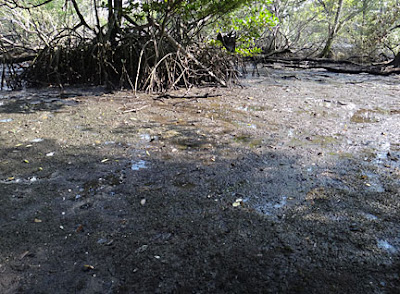This morning, I finally made the stream crossing to get to another part of Mandai that I've long wanted to explore.
Here I am on the other side, looking at the rest of Mandai mangroves. The area turned out to be larger than I expected!
There's quite a lot of trees in this part of Mandai mangroves!
There were several large trees, but not as many as in the rest of Mandai. Most of the large trees were Api-api trees including Api-api bulu (Avicennia rumphiana), Api-api putih (Avicennia alba), and Api-api ludat (Avicennia officinalis) which seem to be fruiting. On the outer edges near the shore there were many small and some large Perepat (Sonneratia alba).
There were two very large Bakau minyak (Rhizophora apiculata) and a few smaller Bakau kurap (Rhizophora mucronata). I saw some Mangrove wax plants (Hoya spp.) and Nipah palms (Nypa fruticans) too.
I came across a Bruguiera grove with lots of knee roots sticking out of the sandy ground!
Most of the trees seem to be Bakau putih (Bruguiera cylindrica) and as usual, many were heavily laden with nice green seedlings.
There was quite a few vigorously growing Tumu (Bruguiera gymnorrhiza) and many of them were 'fruiting' with nice fat cigar shaped seedlings hanging off their bright red calyx. So pretty.
I came across several large Endangered Dugun (Heritiera littoralis) as well as a few large Xylocarpus granatum. Also some large Buta-buta tree (Excoecaria agallocha). There was only a few tall skinny Teruntum putih (Lumnitzera racemosa).
How nice to come across quite a large patch of the rare Beccari's seagrass (Halophila beccarii) here.
As in the rest of Mandai, this seagrass grows quite thick and lush.
As elsewhere in Mandai, erosion is affecting many of the trees, which had their roots exposed.
And many large trees have fallen over, like this one behind a small Bakau kurap (Rhizophora mucronata).
I skirted the edge of this mangrove patch and didn't quite get to look closely at the trees growing in the middle of it. I also didn't scrutinize properly for ephiphytes or look too closely at the smaller plants. Will try to do it on another trip! Who knows what treasures may lie hidden here!
As usual, there's quite a bit of rubbish on the shore. Although I saw some footprints, and there are some trails, this area is probably not very heavily visited. Thus, most of the litter probably float in and are not dumped by visitors.
Here's more large litter that probably floated in.
There's a huge expanse of mudflats here, opposite Johor Baru which lies across the narrow Johor Straits. I didn't have a close look at the mudflats either.
But on the way back across the stream, I came across a pair of Mangrove horseshoe crabs (Carcinoscorpius rotundicauda), the smaller male clinging onto the larger female. Indeed, during a Mega Marine Survey, we found many eggs of horseshoe crabs at Mandai. A study found that juvenile horseshoe crabs were found in meadows of Beccari's seagrass (Halophila beccarii). Vast meadows of this rare seagrass has been seen at Kranji Nature Trail, other parts of Kranji and also at Mandai mangroves. So Mandai seems to be a perfect home for our Mangrove horseshoe crabs!
Earlier, on the way in to the mangroves, I came across the very long snake moult that Rick saw earlier. Wah, quite awesome to know that there are large snakes in the tall grass that we bash through to get to the mangroves. Alas, when I'm looking at trees, I totally miss the animals in the mangroves!
Today, there's a lot of research work going on the mangroves. Ben was in the mangroves for his propagule study, Rick was mapping trees as usual, and a pair of ladies were way out on the mudflats hard at work in the hot sun! It's good to know that so many people are working hard to learn more about our mangroves.
Want to visit Mandai and make a difference for our mangroves? Volunteer with Rick for his mangrove mapping project.
It's the end of another exhausting series of low tides. A huge pile of washing, photo processing lies ahead, with lots of meetings as well, before it all begins again in less than a week! Morning low spring tide season is fun, but very tiring.



















